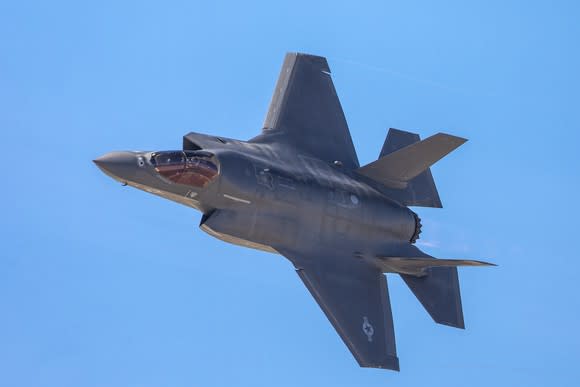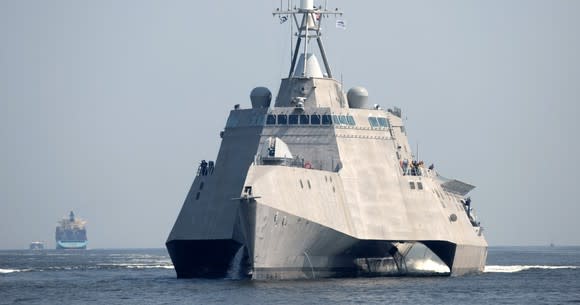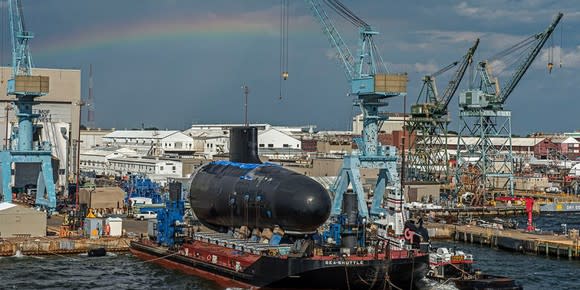6 Companies That Are the Most Reliant on Government Contracts

Image source: Getty Images.
The single largest contractor for the federal government in 2016 was Lockheed-Martin (NYSE: LMT), which raked in more than $43 billion in contracts last year. That was far more than any other contractor received: No. 2 Boeing (NYSE: BA) hauled in just $26.5 billion in contracts.
According to the government's Federal Procurement Data System (FPDS), 58 companies received at least $1 billion worth of government contracts last year, with the top 100 contractors getting over $262 billion combined. What might be surprising is just how dependent some companies are on government spending for their existence.
Boeing's sales to Uncle Sam only amount to 28% of its $94.6 billion in net revenues for 2016, for example. For others, government contracts are their lifeblood. Below are the six companies whose government contracts equate to 60% or more of their net revenue.
Company | Value of Government Contracts 2016 (millions) | 2016 Net Revenue (millions) | Gov't Contracts as % of Net Revenue |
|---|---|---|---|
Lockheed-Martin | $43,399 | $47,248 | 91.9% |
Vectrus Systems (NYSE: VEC) | $925 | $1,191 | 77.7% |
Science Applications International (NYSE: SAIC) | $3,263 | $4,450 | 73.3% |
Austal (NASDAQOTH: AUTLY) | $866 | $1,310 | 66.1% |
Huntington Ingalls Industries (NYSE: HII) | $4,527 | $7,068 | 64% |
Booz Allen Hamilton (NYSE: BAH) | $3,576 | $5,804 | 61.6% |
Data source: Federal Procurement Data System and Yahoo! Finance. Table by author.
Let's take a closer look at what this reliance on government spending means for these businesses.

Image source: Getty Images.
Lockheed-Martin
As the U.S. government's biggest vendor, Lockheed-Martin has the most to lose in times of budgetary constraints. Most of its business stems from the F-35 fighter jet program, which represented 28% of Lockheed's revenue in 2016. Other major programs include the C-130 Hercules and C-5M Super Galaxy military transport aircraft, as well as the F-16 and F-22 fighter jets. Aeronautics program like these represented 38% of Lockheed's net revenue.
President Trump had criticized the cost of the defense contractor's F-35 jets last year, but Lockheed has actually reduced their cost over time, lowering the per-plane costs from around $100 million to $85 million. Trump's tweets at the time shook the contractor's shares, underscoring the sensitivity Lockheed-Martin has to changes in defense spending or the potential for pitting contractors against one another.

Image source: Vectrus Systems.
Vectrus Systems
The "total contract awards" metric for Vectrus Systems is a bit misleading, because the company is in fact fully dependent on the government. It provides facility and logistics services such as airfield and ammunition management, civil engineering, communications, and more, primarily to the U.S. Army. The company says all of its annual revenue for the past three years has come from government customers.
Vectrus' largest contract is its Kuwait Base Operations and Security Support Services (K-BOSSS) in Kuwait, and last year the U.S. Department of Defense did not renew it, causing Vectrus stock to plummet, as the contract represented 37% of total revenue. After an appeal, however, the Army issued a modified contract through March 2018, with options to extend it through March 2019.

Image source: SAIC.
Science Applications International
Better known by its initials, SAIC is another government services provider whose FPDS data doesn't convey the full scope of its ties to government spending. SAIC notes that 95% of its total revenue is derived from government contracts it receives as either a contractor or a subcontractor. The U.S. Army represented 28% of its revenues last year, while the Navy accounted for another 13%.
SAIC has been a longtime market darling due to its embeddedness in government services provision, but a series of underwhelming quarterly performances have caused its stock to fall 13% so far this year, and SAIC says margins were pressured because of "increased costs and investment on our platform integration programs as we work toward completing Marine Corps prototype vehicles." It also lost a lucrative Homeland Security contract late last year.

Image source: Austal.
Austal
Austal is an Australian shipbuilding company that has a U.S. division based in Mobile, Ala. Twice this year, the domestic unit has won contracts to build Independence-class Littoral Combat Ships (LCS) for the U.S. Navy, which it notes are worth about A$8 billion, or about $6.3 billion at current exchange rates. As a result, it's likely we'll see Austal moving up the ranks next year.
And while the shipbuilder is heavily dependent upon the U.S. government for revenue, it's trying to duplicate that success with the Australian government by bidding on a A$3 billion contract to build an offshore patrol vessel for the Royal Australian Navy.

Image source: Huntington Ingalls.
Huntington Ingalls Industries
The second shipbuilder on the list, Huntington Ingalls Industries, is the largest military shipbuilder in the country, having built more ships in more ship classes than any other U.S. naval shipbuilder.
It also just won a new contract recently, this time to overhaul the USS Boise, a Los-Angeles class nuclear attack submarine that's been in service since 1992. The value of the contract, including options, amounts to $385 million for Huntington.
Huntington, and Austal for that matter, ought to benefit from Trump's stated goal of having a 350-ship Navy, including 12 carriers. Under Obama, the Navy had shrunk to just 272 ships last year, and even with its projected shipbuilding program, it would only reach 292 ships by 2046. For that reason, even if Trump doesn't hit his 350-ship mark, it looks like there will be plenty of business for these shipbuilders.

Image source: Booz Allen Hamilton.
Booz Allen Hamilton
Booz Allen Hamilton has been around for over 100 years, but the past few years have not been kind to it, as it has been at the center of some of the country's major national security breaches. Most notably, it was the employer of Edward Snowden, but it has also had employees with high-level security clearances arrested by the FBI for stealing highly classified computer code and leaving sensitive files on an unprotected servers.
Now Booz Allen is under investigation by the Department of Justice for its accounting practices and how it charges the government for its services.
The contractor has managed to recover from each of the Snowden revelations, but like others on this list, it is highly dependent upon the government's largesse. It reports it derived 97% of its revenue from contracts in which the end client was an agency or department of the U.S. government.
More From The Motley Fool
6 Years Later, 6 Charts That Show How Far Apple, Inc. Has Come Since Steve Jobs' Passing
Why You're Smart to Buy Shopify Inc. (US) -- Despite Citron's Report
Rich Duprey has no position in any of the stocks mentioned. The Motley Fool has no position in any of the stocks mentioned. The Motley Fool has a disclosure policy.

 Yahoo Finance
Yahoo Finance 